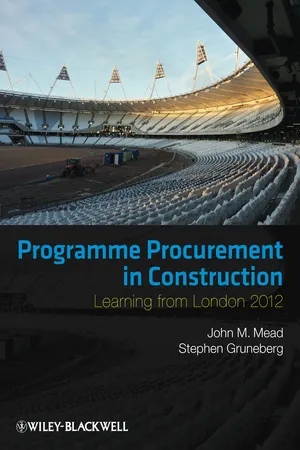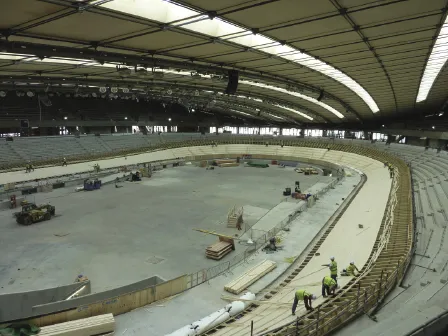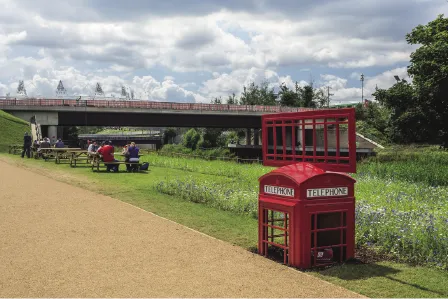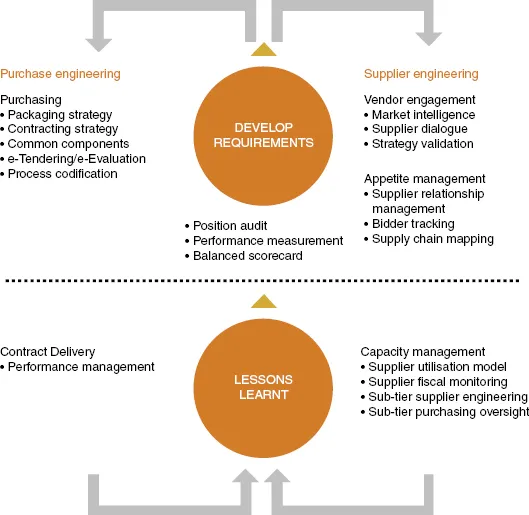![]()
1
Purchase and Supplier Engineering and the London 2012 Olympics
Introduction
The Games of the 30th Olympiad, held in London during the summer of 2012, gave the UK international exposure. The construction of the Olympic Park in east London and all the other Olympic venues around the country continues to receive critical acclaim. The construction of the Olympic infrastructure just had to be delivered on time; no Games had ever been delivered late and London was certainly not going to be the first. After six years of work the delivery of the ‘greatest show on earth’ was heralded as a triumph. This book describes how certain elements of the construction programme required to stage the Games contributed to that triumph.
In this opening chapter we therefore introduce the concept of Purchase and Supplier Engineering (PSE) and highlight the key distinguishing features of PSE from other, more standard approaches to programme procurement and supply chain management.
The Olympic Games requires the host country to deliver a spectacular stage on which the Games can be played. The scope and specifications for the infrastructure requirements of the London 2012 Olympic and Paralympic Games were no different from the 29 other Games that had preceded them. They were both diverse in engineering terms and highly complex and they were constrained by an immovable deadline for delivery – namely the opening ceremony. The project had to be completed on time and to budget, while also delivering against the legacy and environmental commitments described in London’s bid proposal to host the 2012 Games. What made this challenge especially difficult was not only its scale, but that it involved almost all construction disciplines and required them to respond and overcome numerous design, engineering and construction problems. Moreover, a large and visible part of the delivery concerned the construction of sporting stadia at a time when the construction of Wembley Stadium had encountered major time and cost overruns, to the detriment of all concerned, which perhaps added to the initial reluctance of some firms to engage on the Olympics programme.
The scale of the Olympic Delivery Authority (ODA) work to deliver the stage for the London 2012 Games was valued at around £9.2 billion. Delivery of this massive investment required the procurement of approximately 2000 separate contracts in a period of less than five years. The number of contracts was comprised of approximately 250 major, large-scale construction contracts (tier 1 contracts), with the bulk of the remainder consisting of predominantly smaller procurements.
The approach adopted to procure the infrastructure required to stage the London 2012 Olympic Games has received praise from various quarters. For example, it was commended by the ODA Chairman, Sir John Armitt, as a model for other programmes to adopt. His report, ‘London 2012 – a global showcase for UK plc’ (2012), published on completion of the construction programme, highlighted the approaches to supply chain engagement and procurement as key contributing factors to the success of the Olympic delivery programme. The Constructing Excellence report ‘Never Waste a Good Crisis’, published in 2009 following the global ‘credit crunch’, stated that: . . . the ODA procurement model needed to be captured and promoted not just in the UK, but around the world.
The construction of the London 2012 infrastructure stands out as one of the largest and most successful construction projects ever undertaken in the UK. The delivery model and programme management techniques used were both innovative and robust and helped to place the UK construction industry at the forefront of international construction achievements.
The procurement model that was developed for the Olympic delivery has since been consolidated into a model for procurement and supply chain management called Purchase and Supplier Engineering (PSE). The contents of this book are structured to follow the PSE model in its chronological order, or at least as close to that as is possible. A programme by its very nature is so vast that, while the starting point for PSE is the same as for any project, many aspects that follow are likely to occur simultaneously on the many project and package procurements and contracts that make up the programme.
The concept of Purchase and Supplier Engineering
Purchase Engineering and Supplier Engineering are the two key constituent parts that make up the PSE model. The term ‘Purchase and Supplier Engineering’, or PSE, was introduced after the concept was developed and deployed on the London 2012 programme. In later chapters the constituent parts that make up the complete concept of PSE are described in more detail. By way of simple introduction PSE can be described as being similar to procurement and supply chain management. However, in order to highlight PSE’s specific features, compared to the more traditionally held procurement and supply chain management (SCM) approaches, the application of the PSE model is described to illustrate the overall concept that has now been deployed on two of the largest construction programmes delivered in the UK in modern times – namely, the London 2012 infrastructure programme at over £9 bn and the Crossrail railway programme at some £14 bn.
PSE is a tried and tested approach, used effectively on a number of construction programmes to deliver a successful built-environment solution from a global supply marketplace. It is an approach that delivers the values and goals of the client across multiple projects within a highly complex programme or portfolio environment. The PSE approach sets out at the earliest stages to deliver the values and goals of the client.
While the PSE model was developed in response to the challenges of delivering the London 2012 Games’ infrastructure, since its deployment on this programme it has been further developed and many elements of the model deployed on numerous other programmes of varying sizes and complexity.
Major construction projects and programmes are by their nature extremely multi-faceted, involving the mobilisation of resources employing complicated technical solutions. Nevertheless, this complexity can be managed by breaking the whole, regardless of its size, into appropriate and manageable parts and solving each of them individually. No overarching approach can be applied to meet all the requirements of a complex client and its many stakeholders’ contradictory objectives and conflicting interests. However, it is possible to propose a consistent method for analysing each package of work and the capability and capacity of the many firms required to deliver these to meet the priorities set out for their particular part of the project.
Doing so ensures that each firm is capable of fulfilling its obligations to the project and, taken as a whole, all the firms then contribute towards the successful completion. This applies equally to the whole construction value chain, made up of main contractors, their subcontractors and their suppliers. PSE is a technique that can be used to measure and establish the capacity, capability and reliability of each firm in the supply chain even prior to selection. As procurement is not only about appointing contractors but is also very much a starting point in the process of delivery, PSE also deals with managing and monitoring certain aspects of the firms throughout their engagement.
Programme management is not the same as project management. Programme management is therefore definitely not the sum of project management multiplied across a number of projects in a programme. Therefore, because procurement on a programme cannot be about procuring each project in isolation, a much more strategic approach is required. The impact of one project on the total programme must be considered in the context of the whole. In a programme made up of, say, ten projects, nine successful projects would not equate to a successful programme. Therefore, PSE is not just concerned with each project; it adopts a far more strategic view of the programme’s procurement and the capability of the supply chain to meet the programme’s requirements.
PSE is based on the understanding that procurement is about buying a supply chain, and not just an individual contract. PSE also takes into account the wider supply issues, such as the capacity of suppliers to meet a project’s needs and the wider programme’s aggregate level of demand. It seeks to understand the exposure of suppliers in the context of their financial strength, the effect the programme has on this and also the wider economic impact of the programme. PSE therefore takes the view that the successful project is not as important as the successful programme, and that the successful programme is not achievable without the successful businesses that form its delivery supply chain.
Figure 1.1 below highlights the processes and strategies of the purchase engineering and supplier engineering streams that make up the PSE model. These streams are fundamentally linked to each other and assist in laying the foundations of the future success of a programme’s delivery.
The purchase engineering and the supplier engineering functions together inform the procurement and delivery process and thereby ensure that the risks associated with procurement are managed, while opportunities are created and in doing so the client’s value requirements are realised.
Purchase Engineering seeks to establish a strategy and methodology for assembling a purchasing ‘machine’ that can be used to procure any number of contracts efficiently to deliver the objectives of a client.
Similarly, Supplier Engineering aims to establish a framework for the programme supply chain team’s interactions with the supply chain organisations that are seen as critical to the success of construction. This engagement is both during the pre-construction (procurement) and construction (delivery) phases. PSE helps to remove surprises during procurement and assists in the avoidance of certain project and programme supply chain risks during delivery that could otherwise lead to major cost and time overruns and undermine the value-for-money requirements of the client.
The PSE model is shown in Figure 1.1. The dotted line dividing the top and bottom halves of the diagram distinguishes between those elements of the model that are delivered during procurement, such as packaging strategy (above the line) and those that impact on delivery post-contract award, such as performance management (below the line).
Programme organisation – an Olympic case study
It is important to recognise at the outset that even large public-sector clients may be headed by people newly appointed to positions of authority. Often there is little qualified and experienced staff to support them and those that are available are not always to hand. This is partly the result of the practice of outsourcing expertise in the public sector. Moreover, there may be little build-up of relationships between the public sector and contractors over a prolonged period of time. By the nature of construction contracting, relationships tend to last only for the duration of projects; there is little opportunity for working relations to become established over a working life. This leads to problems of communication that need to be carefully managed.
For example, even before embarking on a project, contractors need to know what the client’s requirements are. This goes beyond simply describing the building in technical terms. Large projects involve complex interactions, including social, environmental and economic aspects. Clients may initiate procurement in the built environment with an understanding of how they perceive success in a project, but without a clear way of explaining this to the supply chain.
Without a clear value definition, supply chains cannot respond to client requirements, as they do not necessarily understand their employers’ expectations. Not being fully aware of these requirements, contractors cannot respond to these expectations clearly and coherently when putting tenders together. Clients also find it more difficult to evaluate tenders beyond the objective requirements of price and technical specifications, if they have not effectively communicated their value framework. The client might well have to meet demands from a variety of different stakeholders, with varying degrees of influence and power over their project, programme or portfolio.
These demands can be numerous and can come from inside the client organisation as well as from external stakeholders. The social and political implications need to be taken into account, as the impact of the addition of a new building on the built environment can affect third parties, such as local businesses, residents and amenities. Whether this impact is positive or negative, or is even considered, will depend on the client’s priorities and their need or desire to take various factors into consideration. Publicly funded projects, for example, must demonstrate ‘best value’, but very often what represents value is unclear and sometimes even remains unstated beyond the most basic description. Conventionally, clients describe value in three relatively simple terms. These are cost, time and quality. However, that is no longer adequate or sufficient, as objectives extend beyond the built asset especially in the public sector, where there is often a need to take into account environmental factors, health and safety and the social impacts that may occur.
The Olympic Delivery Authority (ODA) was the public body put in place and made responsible for developing and building the new venues and infrastructure necessary for hosting the London 2012 Olympic and Paralympic Games. A delivery partner, CLM, was appointed via a public procurement competitive dialogue process to work with the ODA to programme-manage the delivery of the construction of the venues and infrastructure for the Games.
The ODA was established by the London Olympic Games and Paralympic Games Act (2006). The...




